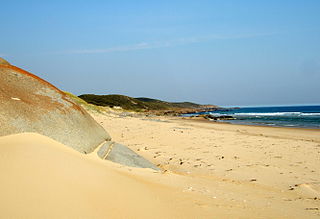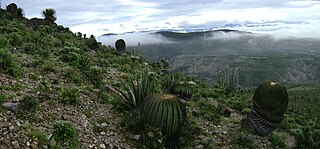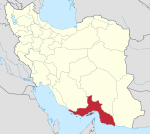
The Croajingolong National Park is a coastal national park located in the East Gippsland region of the Australian state of Victoria. The 88,355-hectare (218,330-acre) national park is situated approximately 450 kilometres (280 mi) east of Melbourne and 500 kilometres (310 mi) south of Sydney.

A nature reserve is a protected area of importance for flora, fauna, funga, or features of geological or other special interest, which is reserved and managed for purposes of conservation and to provide special opportunities for study or research. They may be designated by government institutions in some countries, or by private landowners, such as charities and research institutions. Nature reserves fall into different IUCN categories depending on the level of protection afforded by local laws. Normally it is more strictly protected than a nature park. Various jurisdictions may use other terminology, such as ecological protection area or private protected area in legislation and in official titles of the reserves.

Hormozgan Province is one of the 31 provinces of Iran. It is in the south of the country, in Iran's Region 2, facing Oman, the United Arab Emirates and the Hormuz Straits. Its area is 70,697 km2 (27,296 sq mi), and its provincial capital is Bandar Abbas. The province has fourteen islands in the Persian Gulf and 1,000 km (620 mi) of coastline.
There are 18 biosphere reserves in India. They protect larger areas of natural habitat than a typical national park or animal sanctuary, and often include one or more national parks or reserves, along with buffer zones that are open to some economic uses. Protection is granted not only to the flora and fauna of the protected region, but also to the human communities who inhabit these regions, and their ways of life. In total there are 18 biosphere reserves in India.
The wildlife of Iran include the fauna and flora of Iran.

The Mangrove forests of Qeshm or Hara forests of Qeshm, are the mangrove forests on the southern coast of Iran, particularly on and near the island of Qeshm in the Persian Gulf. Dominated by the species Avicennia marina, known locally as the "hara" or "harra" tree, the forests represent an ecological resource. The "Hara Protected Area" on Quesm and the nearby mainland is a biosphere reserve where commercial use is restricted to fishing, tourist boat trips, and limited mangrove cutting for animal feed.

Miyānkāle peninsula is a long, narrow peninsula in Behshahr County of Māzandarān Province in the north of Iran situated in the extreme south-eastern part of the Caspian Sea. The elongate peninsula is 48 kilometres long, and between 1.3 and 3.2 kilometres wide.

Protected areas of Poland include the following categories, as defined by the Act on Protection of Nature of 16 April 2004, by the Polish Parliament:

Repetek Biosphere State Reserve, often referred to as Repetek Nature or Desert Reserve, is a desert nature reserve (zapovednik) of Turkmenistan, located in Lebap Province, East Karakum Desert, near Amu Darya. It is located approximately 70 km (43 mi) south from Türkmenabat and is known for its zemzen. Established in 1928 for the study and preservation of a sand-desert ecosystem, it covers an area of 346 km2 (134 sq mi).

Cold Desert Biosphere Reserve is a biosphere reserve located in the Western Himalayas, within Himachal Pradesh in North India. It was established as a biosphere reserve in August 2009. Biosphere reserves are the areas of terrestrial and coastal ecosystems which promote the conservation of biodiversity with its sustainable use. There are over 738 biosphere reserves around the world in over 134 countries. The ministry of environment and forest provides financial assistance to the respective state governments for conservation of landscape, biological diversity and the cultural heritage. This region has the status of a Cold Desert biome. This region carries the status of a Cold Desert biome for two reasons, one is the leeward part of the Himalayas which is spared from monsoon winds and the other is its position at high altitude, on average 3000–5000 metres.
Biosphere reserves are established according to the UNESCO's Man and the Biosphere Programme (MAB) to promote sustainable development for conservation of biological and cultural diversity. As of 2016, the Lal Suhanra Biosphere Reserve and Ziarat Juniper Forest are the only two biosphere reserve in Pakistan, which were approved by UNESCO in 1977 and 2013 respectively. A number of initiatives and projects have been undertaken to promote and develop other biosphere reserves in Pakistan but due to weak implementation this has not yet been materialized. In July 2012, Pakistan Museum of Natural History and Beijing Museum of Natural History signed a MoU to work on trans-boundary biodiversity and to improve MAB related activities in the Karakoram, Himalaya, and Hindukush regions.

The wildlife of Mongolia consists of flora, fauna and funga found in the harsh habitats dictated by the diverse climatic conditions found throughout the country. In the north, there are salty marshes and fresh-water sources. The centre has desert steppes. In the south, there are semi deserts as well as the hot Gobi desert in the south, the fifth-largest desert in the world.
The Komodo Biosphere Reserve and National Park is situated between Flores and Sumbawa in Indonesia. It is renowned for its population of about 5,000 giant lizards, called 'Komodo dragons'. They exist nowhere else in the world and are of significant interest to scientists studying the theory of evolution.

The Tehuacán-Cuicatlán biosphere reserve is a protected natural area located in southeastern Mexico. Its name derives from its two main locations: Cuicatlán and Tehuacán, in the latter are their administrative offices, covers 490,186 hectares distributed among 21 municipalities in the state of Puebla and Oaxaca.

Oka Nature Reserve is a Russian 'zapovednik' located in the Meschera lowlands, the floodplain of the Oka River and the Pra River. With extensive lowland rivers and forested peatlands, the reserve is an important area for waterfowl and waders. The reserve hosts breeding centers for bison and for crane. The site is situated in the Spassky District, Ryazan Oblast, about 60 km northeast of the city of Ryazan. In 1994, the "Flood plains of Rivers Pra and Oka" was designated a Ramsar wetland of international importance. The site was designated a UNESCO Man and Biosphere (MAB) reserve in 1978. The reserve was formally established in 1935, and covers an area of 55,722 ha (215.14 sq mi).

Taymyr Nature Reserve is a Russian 'zapovednik' located in the northern lowlands of Siberia, on the Taimyr Peninsula, and on the coast of the Laptev Sea of the Arctic Ocean. The reserve includes the most northern forest of Dahurian larch in the world, and also the most northern mainland mountain range in the world. The protected area was established to protect the breeding grounds of the Red-breasted goose as well as the summer residences of wild reindeer and the biodiversity of the Lake Taymyr. The reserve is situated about 120 km east of the town of Norilsk, and 3,000 km northeast of Moscow, in the Taymyrsky Dolgano-Nenetsky District of Krasnoyarsk Krai. In 1995, the site was designated a UNESCO MAB Reserve. The reserve was formally established in 1979, and covers an area of 1,781,928 ha (6,880.06 sq mi).

The Islas MaríasBiosphere Reserve is a UNESCO Biosphere Reserve located in the Islas Marías in the municipality (municipio) of San Blas, Nayarit, Mexico. The 641,284.73 hectares (2,476.0142 sq mi) reserve includes ecosystems with a great wealth of species of biological, economic, scientific and cultural relevance. Its biological wealth is to be found in the dry forests of its landscape, in the mangroves, the succulent rosette scrubland, the reefs, coasts and pelagic environments it harbors.

The Volcán Tacaná Biosphere Reserve is a UNESCO Biosphere Reserve at the Tacaná Volcano in Chiapas, Mexico, on the border with Guatemala. The volcano is part of the Central America Volcanic Arc. The 6,378 hectares (24.63 sq mi) reserve contains fragile ecosystems very rich in wild flora and fauna species of cultural, scientific, economic and biological relevance. Its rich biodiversity and high endemism are found particularly in the high mountain ecosystem and landscapes and in the volcanic edifice which presents geophysical features of great scientific and aesthetic value. Average annual rainfall can amount to 2,000–5,000 millimetres (79–197 in), as in the case of Soconusco.

Uzunbodzhak, also transliterated as Ouzounboudjak is an UNESCO Biosphere Reserve, one of the five nature reserves in Strandzha Nature Park in south-eastern Bulgaria. The reserve is sometimes called Lopushna. Uzunbodzhak was established on 13 December 1956 and was included in the UNESCO network of biosphere reserves in March 1977. It covers an area of 2529.6 hectares, or 25.296 km2. All economic activities are prohibited on the territory of the reserve.
The biosphere reserves of Iran have a total land area of 1.64 million km2. They support more than 8,000 recorded species of plants, 502 species of birds, 164 species of mammals, 209 species of reptiles, and 375 species of butterflies.



















